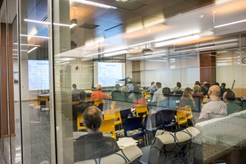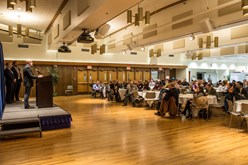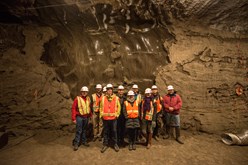Center for Safety Equity in Transportation
rural • isolated • tribal • indigenous
The Center for Safety Equity in Transportation (CSET) is sponsoring a monthly webinar series. Topics covered range from naturalistic driving data to use of CAV and drones in rural areas. Projects listed on the research page are presenting their results. Additionally, presentations on topics related the rural, indigenous, tribal and isolated communities are presented. The presentations are recorded and posted on the AIDC YouTube channel. If you are interested in receiving webinar announcements, please contact us at cset.utc@alaska.edu.
CESTiCC/CSET Director Billy Connor engaged with 5th and 6th grade students from the Alaska Gateway School District and 6th grade students from Salcha Elementary School during the annual Kids2College event on April 12, 2019. Billy introduced the students to Engineering as a career and the importance of Civil Engineering to a safe transportation infrastructure. He presented concepts of friction and safe stopping distances to the students, then all participated in an activity to calculate friction coefficients on ice, gravel and pavement and relate those to distance required to stop on each surface while driving. Students from the UAF Department of Civil and Environmental Engineering (CEE) assisted the kids at the activity stations make the required measurements. The photo on the left was taken while Billy was giving the overview on Engineering as a career to the students from Salcha Elementary School. The photo on the right shows Fred Sommer, a UAF Civil Engineering student assisting students measuring the coefficient of friction on pavement.

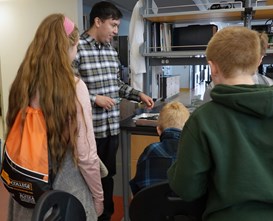
UAF’s College of Engineering and Mines (CEM) hosts an engineering week open house every year in conjunction with national engineers week. The event is an opportunity for the Fairbanks community to discover, engage and enjoy all things engineering. This year’s open house held on Saturday, February 23rd, was attended by approximately 500 people and all activities were located in the Engineering Learning and Innovation Facility. CSET’s "Safe Stopping Distance" activity focused on determining the friction coefficient for different surfaces to calculate the safe stopping distance. Measurements were taken on ice, gravel and dry pavement and used to calculate the friction coefficient of each surface. The friction coefficients were then input into the stopping distance formula to calculate the distance required to stop at 45 mph on each surface. Many attendees were startled by the distances required to stop.
CSET wishes to express our appreciation to CEM for sponsoring the event and to our CSET volunteers. Everyone had a great time, and we’re hoping it won’t be too long before we see these transportation engineers on campus! In the photo below Tristan Sayre, a senior in civil engineering at UAF, demonstrates measuring the pull force required to move a wooden block with tire treads across a gravel surface. The pull force is a required measurement for calculating the friction coefficient of a surface.

Miah, Mintu M. and Panos D. Prevedouros, Effects of Reading Text While Driving: Analysis of 200 Honolulu Taxi Drivers on a Simulator, Paper 19-00176, 98th Annual Meeting of the Transportation Research Board, Washington, D.C., 2019. In poster session 1311, Hall A, B375, Mon., Jan. 14, 130-300P.
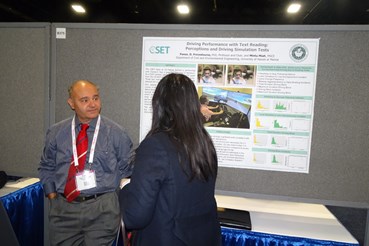
Third grade students from Northstar Elementary school visited the University of Alaska Fairbanks (UAF) campus on November 8, 2018. The students were provided an opportunity to visit the engineering labs. Tristan and Dylan, UAF students in Civil and Environmental Engineering, provided a presentation on the different types of concrete and demonstrated the differences in concrete strength by crushing concrete cylinders.The students found the demonstrations engaging and were enthusiastic about learning the differences in concrete mixtures.


CSET participated in the 2018 Alaska Federation of Natives Conference held in Anchorage, Alaska October 18-20. The Center had a booth in the exhibit hall in order to interact with conference attendees. A voluntary survey was conducted to obtain input from across Alaska on transportation safety issues.
The Pacific Northwest Transportation Consortium (PacTrans) and Center for Safety Equity in Transportation (CSET) hosted the 2018 Region 10 Transportation Conference on October 12th, 2018 at the University of Alaska Fairbanks. The theme, North to the Future: Emerging Mobility and Safety Issues in the Pacific Northwest, engaged participants in dialogue on how to move the state of our transportation system forward while being conscious of safety and mobility implications. More than 130 professionals, academics and students in the field of transportation engineering attended the conference, many of whom came from outside the state of Alaska.
The keynote address of the conference was provided by Ryan Anderson, Assistant Commissioner of the Alaska Department of Transportation and Public Facilities (AKDOT&PF), titled “Moving Safer, Moving Smarter, Transportation in Alaska.” The conference included 3 mobility focused sessions running concurrently with 3 safety focused sessions. The closing panel focused on balancing safety and mobility with 4 panelists: Anne Chang, SAE International, Dan Schacher, AKDOT&PF, David Yang, AAA, and Daniel Work, Vanderbilt University. The complete agenda is located here.
Students also had the opportunity to attend a special session focused on career development provided on October 13. Colin Singleton, CRW Engineering Group, Jackson Fox, Fairbanks Metropolitan Area Transportation System, and Marc Luiken, AKDOT&PF each presented on a transportation engineering topic to a group of approximately 30 students.
Registered attendees of the conference were provided the opportunity to take an excursion focused on permafrost and its impact on Alaska Infrastructure on Saturday, October 13. The excursion included visiting the Permafrost Tunnel, created and maintained by the Department of Defense for research purposes and a stop at the Trans-Alaska Pipeline visitor’s center. Those who took advantage of the excursion found it a highlight of their trip. Details on the locations visited can be found here.
